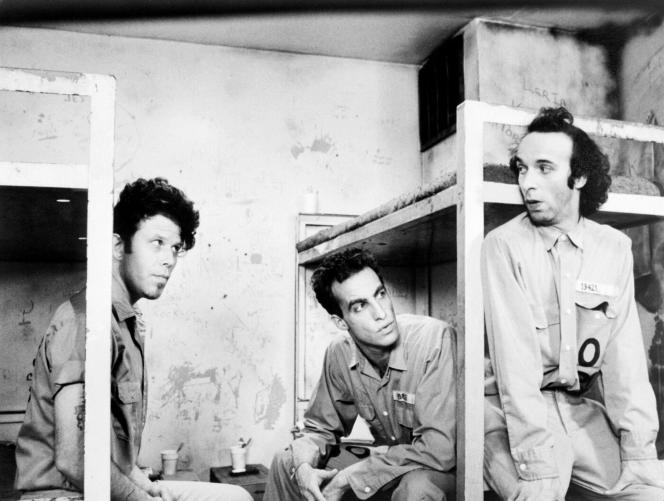ARTE.TV – ON DEMAND – FILMS
From one wandering to another, from Allie’s vagrancy in the streets of a New York in ruins, to the initiatory journey of an accountant from Cleveland, in a West populated by mystical visions, the first half of the work by Jim Jarmusch, Permanent Vacation (1980), his graduation film, at dead man (1995), sound “psychedelic western” in his words, deploys his mysterious geography on Arte.tv. Might as well warn right away, lack Stranger Than Paradisehis second feature film, the first to be distributed in France, which earned the author the Camera d’Or at Cannes in 1984.
We will do without it, because the five films available draw an immediately recognizable and yet almost elusive cinematic landscape: how to draw a line from the bayous of Louisiana (Down by Law) to the snowy streets of Helsinki (Night on Earth). Emotions, sensations, obey the same fluidity. It would be a mistake to reduce Jim Jarmusch’s mood to idiosyncratic humor, tinged with melancholy. She is there, she is only one of the characteristics of the cinema of the author of Broken Flowers (2005), which embraces both the death instinct and amorous passion, friendship and loneliness.
Of the Permanent Vacation, Allie, the young man who wanders aimlessly through the streets of lower Manhattan, remembers his Jewish origins and the mystery that led to his people being on the right side of the Atlantic. First DIY film, shot in a city that everyone then believed was destined for disaster, with its disused warehouses and wastelands where nature was taking over, Permanent Vacation brings out a Vietnam veteran, a woman interned in a psychiatric hospital, who influence the course of the indecipherable central character.
Improvisation around a theme
Jim Jarmusch is not the most prolific of filmmakers. In forty-three years, he has directed thirteen feature-length fiction films (including three sketch films) and a documentary (Gimme Dangerin 2016, which tells the story of Iggy Pop and The Stooges). However, if there is a common trait in each of his films, it is this impression of spontaneity, of improvisation around a very strong theme, which often makes them resemble a jazz standard interpreted by a musician from exception.
Moreover, his films with sketches are like little concerts, with their variations and their recurring motifs. On Arte.tv, you can see Mystery Train (1989) and Night on Earth (1991). The first brings to Memphis, Tennessee, a couple of Japanese tourists, an Italian widow and a penniless British loser, played by Joe Strummer. The second travels the planet by taxi, from Los Angeles to Helsinki, via New York, Rome and Paris. The taxis are driven by Winona Ryder, Armin Mueller-Stahl and Giancarlo Esposito, Isaach de Bankolé, Roberto Benigni (who had already filmed under the direction of Jarmusch in Down by Law) and Matti Pellonpää, Aki Kaurismäki’s chosen actor.
Lighter than Mystery Trainthis compilation is akin to the fantasy of Down by Law (1986), which precipitated a trio made up of musician John Lurie – a major figure on the New York scene -, Tom Waits and Roberto Benigni (for whom Jarmusch showed inexplicable indulgence) on the trail of the heroes of prison films from the golden age of the studios, I am an escapee (Mervyn LeRoy, 1932) or Sullivan’s Travels (Preston Sturges, 1941).
an epic poem
Stay dead manwhich opens with an epigraph by Henri Michaux − “It is always better not to travel with a dead person” −, begins with a hellish journey by train of a young accountant from Cleveland (Ohio), named William Blake, after the English mystical poet, through a West littered with the bones left behind by the pioneers. Johnny Depp lends this involuntary pilgrim character his then angelic physiognomy. Soon the accountant turns into a fugitive, then a formidable outlaw, accompanied at every step by a formidable character whose name is Nobody, an Amerindian intellectual played by Gary Farmer.
In these landscapes where the history of the United States and its mythology, the extermination of the First Nations and the western were shaped, Jarmusch unrolls an epic poem accompanied by the formidable electric and funereal score that Neil Young improvised on the guitar.
The filmmaker maintains an intimate relationship that is unique to him. He is not the king of needle drop, these moments that we sublimate thanks to the irruption of a monument of the pop or classical repertoire, of which Martin Scorsese is the undisputed master. Jarmusch creates a dialectic between dramaturgy and music, whether original (Tom Waits’ soundtrack for Night on Earth) or borrowed (the Ethiopian jazz of Mulatu Astatke in Broken Flowers), playing on the contrasts between tones or eras. He does it, like all the rest of his cinema, with a modesty, a deliberate absence of virtuosity, which sometimes masks his true stature.
Jim Jarmusch cycle with five feature films: Permanent Vacation (1980), Down by Law (1986), Mystery Train (1989), Night on Earth (1991), dead man (1995). Available on demand on Arte.tv until December 31.
